Introduction
The success of the author and his post is associated to the reward it receives. The reward amount is dependent to the Number of Upvotes and Voting Weight Percentage a post receive. However, reaching a large number of upvotes does not assures an author recieves a bigger reward. It will always go down to the the voting weight and the steem power (SP). The problem with reaching this desired numbers of upvotes and rewards goes down with the question: Have it reach a wider audience? or Have it reach a curator?
There are hundreds of post every everyday. For a post to get noticed it should have to be promoted. Resteem is a feature in the platform that your post is get promoted to more audiences by either your followers or by users who is interested in your post. Recently, their are resteeming bots avilable in the plaform that will help you promote your post to its follower by sending a fix SBD or STEEM price.
Thus, I consolidated data that will show that relationship between net payout and number of resteems an author received. The analysis will try to quantify the relationship using a correlation statistics between net payout and number of resteems. The result of this analysis will give a clearer perspective of the effect of resteeming to the generated reward.
Analysis Outline
- Data extracted at @arcange 's SteemSQL at February 3 , 2018 at 10:30 PM ( UCT +8).
- The analysis features the no. of resteem per author and net payout according to the12 month time frame( January 1, 2017 to December 31, 2017).
- This statistical correlation is conducted in a population of 175,504 users with highest net payout and resteem equal to 112,111.898 and 22,734.
- A sample population of the top 100 most resteemed authors will be used in the data presentation.
- This is limited only to the correlation between net payout to the number of resteems. So, it does not include catergory and no. of upvotes.
Scopes and Limitation of Analysis
- The data is extracted from @arcange 's SteemSQL database between a twelve month time frame ( January 1, 2017 to December 31, 2017) .
- The analysis include the No. of Resteem accumulated by authors and the ** Net Payout** it generated for the the period of January 1, 2017 to December 31, 2017
- The data is used to find the correlation confidence between No. of Resteem and the Net Payout
- The analysis does not include No of Upvotes and the No. of Post each users recieve a resteem . The correlation is strictly between No. of Resteem and the Net Payout .
Tools
I extracted the data from the SteemSQL database by importing it through Microsoft Excel using SQL query.
| SQL query script to extract all 172,522 data from steem blockchain |
|---|
SELECT author, COUNT(reblogged_by) as [No of Resteem], SUM(total_payout_value) as [Pending Payout]FROM CommentsWHEREparent_author='' ANDcreated >= '2017/01/01' ANDcreated < '2017/12/31' GROUP BY a uthorORDER BY COUNT(reblogged_by) DESC |
| SQL script use to extract only the Top 100 authors. |
|---|
SELECT TOP 100 author, COUNT(reblogged_by) as [No of Resteem], SUM(total_payout_value) as [Pending Payout]FROM CommentsWHEREparent_author='' ANDcreated >= '2017/01/01' ANDcreated < '2017/12/31' GROUP BY a uthorORDER BY COUNT(reblogged_by) DESC |
The data presentations such tables and graphs are created using Microsoft Excel. For solving the correlation confidence, I use the formula: =CORREL(B:B,C:C), where B:B and C:C are the Resteem and Payout columns form the extracted data in excel.
Results
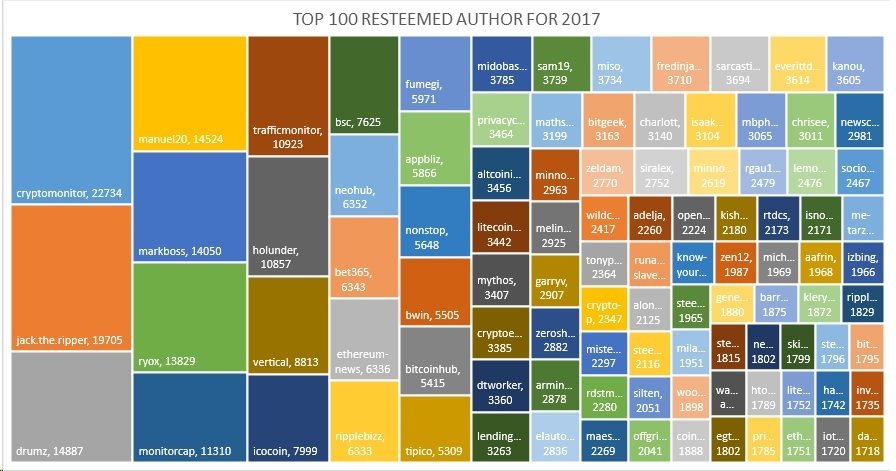
Presented in the tree map above are the Top 100 most resteemed authors for 2017. Leading the list of authors is @cryptomonitor whom recieved 22, 734 accumulated resteem. However, it was @barrydutton who received the most payout among the group. I found out that resteeming does not have a bigger impact in terms of gaining rewards. This is evident that @barrydutton has among the less amount of resteem receive in comparison to @cryptomonitor whon just landed tenth place among the authors with the highest net payout from the sample group. This will be explained in details later on using graphs and the statistical correlation that I have conducted.
Data Presentation for the No. of Resteem
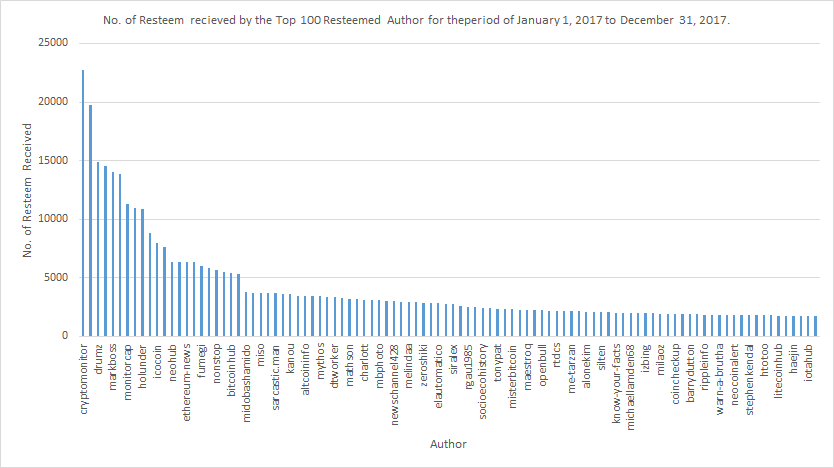
The data extracted from the SteemSQL database reach 175,504 numbers of authors whom received at list 1 resteem has been considered in the SQL query. So, I trimmed down the data to the top 100 most resteemed authors, which can be shown in the graph above. For the sample group of 100 authors, the highest number of accumulated resteem is about 22,734 and the minimum is 1718.
Here is a graph and list of the Top 10 authors who gathered the most resteem.
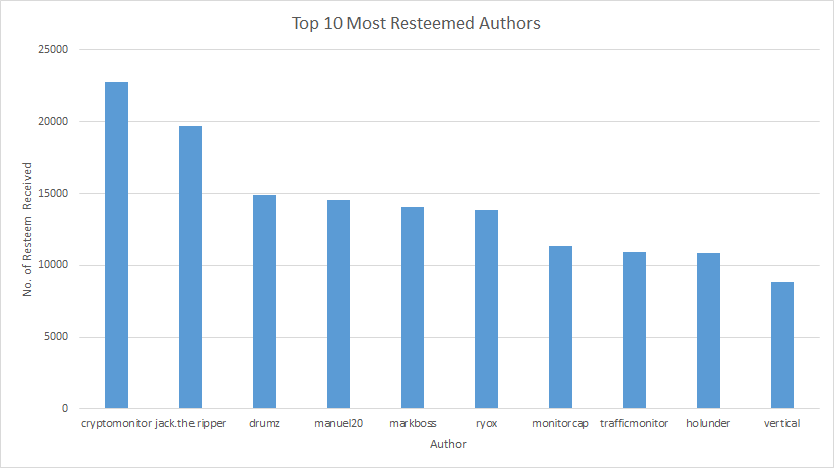
| Author | No. of Resteem receive |
|---|---|
| @cryptomonitor | 22734 |
| @jack.the.ripper | 19705 |
| @drumz | 14887 |
| @manuel20 | 14524 |
| @markboss | 14050 |
| @ryox | 13829 |
| @monitorcap | 11310 |
| @trafficmonitor | 10923 |
| @holunder | 10857 |
| @vertical | 8813 |
Data Presentation for the Net Payout
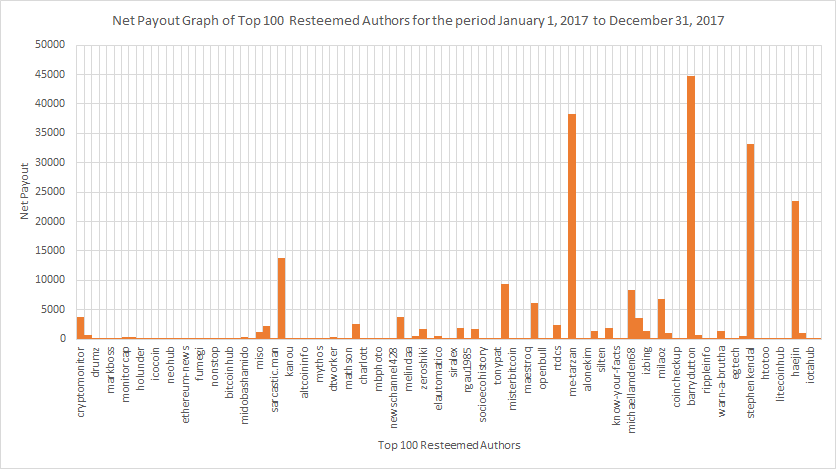
The highest payout received from the list of 172,522 authors is equal to 112,111.898 by @papa-pepper. However, @papa-pepper was not included in the list of 100 hence his accumulated resteem is good for 1152. From the Top 100 most resteemed author, @barrydutton lead the group with 44,774.295 of rewards in SBD and STEEM. If you look at the data on the no. of resteem, @barrydutton is good only for the 84th palce with 1875 resteems recieved. The leading author with most resteemed, @cryptomonitor, is only goodfor the 10th place whom received net payout of 3,816.458 of SBD and STEEM.
Here is the complete list of the Top 10
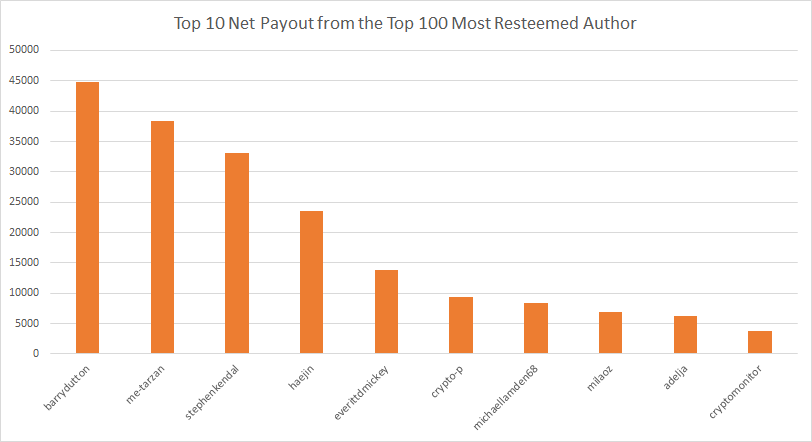
| Author | Net Payout receive |
|---|---|
| @barrydutton | 44,774.295 |
| @me-tarzan | 38,297.706 |
| @stepenkendal | 33,114.189 |
| @haejin | 23,500.615 |
| @everittdmickey | 13,864.011 |
| @crypto-p | 9,372.469 |
| @michaellamden68 | 8,378.992 |
| @milaoz | 6,836.143 |
| @adelja | 6156.16 |
| @cryptomonitor | 3,826.458 |
Data Interpretation
From the presented data earlier, the no. of resteems does not directly or proportionally translate into rewards. This is evident in gap between values receive by each authors in the top 10 for both data presented.
For example, @cryptomonitor tops the most resteem recieved but placed tenth on the most payout in the sample group. Another instance is that, @papa-pepper has the most payouts from the 172,522 authors but not included in the top 100 most resteemed because of a low resteem counts. Same goes with @barrydutton. He was not on the top 10 for no. of resteem but tops the sample group with his most payouts.
When you look at the graph below, somehow, you can say that there is a relative proportionality in the data. it is observable in the trends shown in the graph below. As the resteem counts decrease, the payout also decreases.
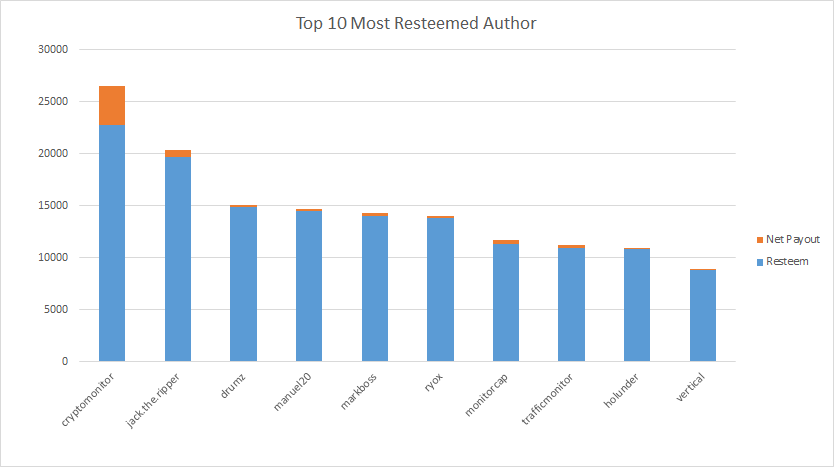
Take a look at the resteem counts of @haejin and @adelja in the graph below. You can observe that @adelja has a better resteem counts than @haejin. However, @haejin recieves more payout than @adelja.
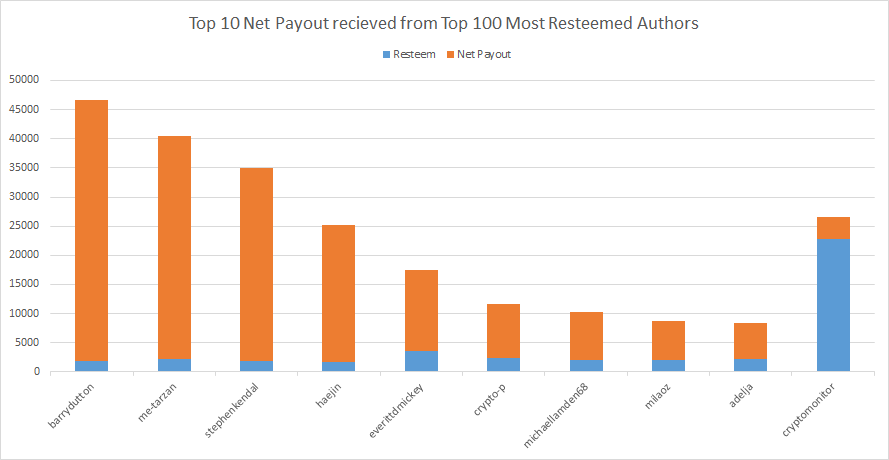
If we take in consideration the second graph, the earlier observation that: " as the resteem counts decreases, the author payout also decreases" is negated. It is because there is no observable linear proportionality between those two variables.
Correlating No. of Resteem and Net Payout
The graph below shows a linear plot of the No. of Resteem and Net Payout. It is observable that their is no linear relationship between the two graph presented. There are some authors who receive a smaller no. of resteem but receives bigger payout as compared to those who receive the better no. of resteem.
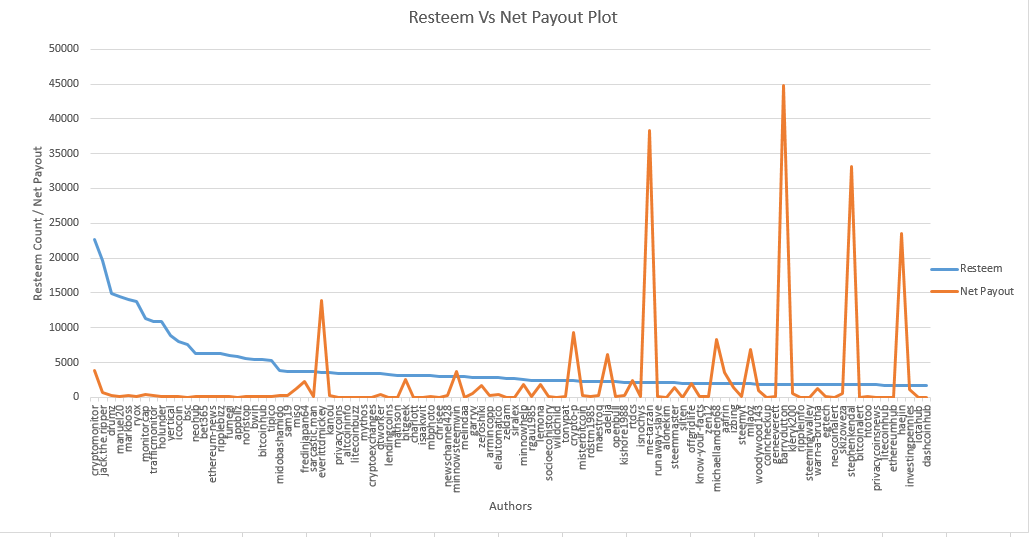
After conducting a correlation statistic between the No. of Resteem and Net payout recieved by the on 175,504 authors, it result to correlation coefficient equal to 0.15375.
Correlation coefficient is a number between -1 and 1 which represent the linear dependency of two variables. Below are the common levels of correlation:  . . |
|---|
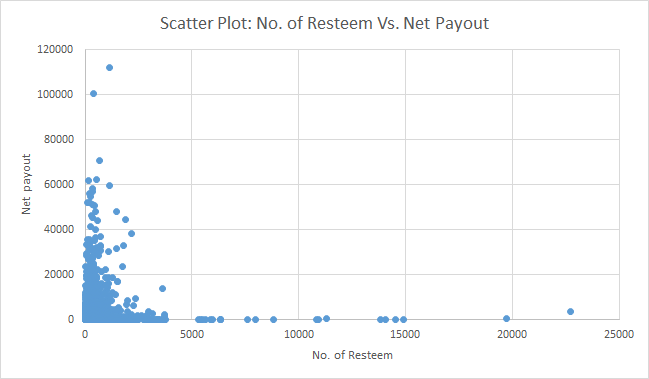
(This is the scatter plot for 175,522 authors.)
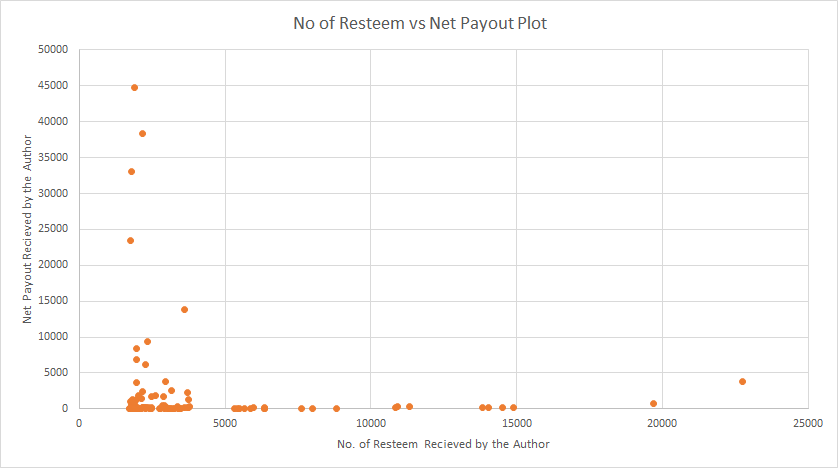 (This is the scatter plot for TOP 100 resteemed authors.)
(This is the scatter plot for TOP 100 resteemed authors.)I am presenting two sets of scatter plot as shown. Both points out to a data concentration between 0 to 5000 resteem counts receiving the most payout. Based on the correlation coefficient of 0.15375, i can say that there is a very low positive correlation between the no. of resteem and net payout. Take note that correlation does not means causation. Correlation does not mean that when there is an increase in the no. of resteems, it causes an equal increase in the payout. A low positive correlation means that in some ways the no. of resteems can attribute to a positive amount in payout; but, does not cause the increase in the payout. This is evident in the data concentration between 0 to 5000 resteems.
Conclusion
The no of resteem an author received attributes some positive gains in rewards; but, receiving a large no. of resteem does not means a substantial increase in the net payout receive by the author.
Posted on Utopian.io - Rewarding Open Source Contributors
